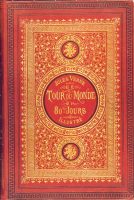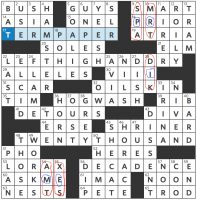Mike Shenk’s Wall Street Journal contest crossword, “Sound Investment”—Laura’s review
This week we’re asked to find a five-letter financial term. We have five starred entries; whaddaya wanna bet that each one suggests a letter?
- [17a: School writing assignment]: TERM PAPER
- [22a: Deserted]: LEFT HIGH AND DRY
- [36a: Rot]: HOGWASH
- [48a: Number in a Jules Verne title]: TWENTY THOUSAND
- [56a: Overindulgence]: DECADENCE
This is one where I made a list of the themers and stared fruitlessly at them for about 13 minutes, then had a breakthrough and solved the meta in a couple of minutes. Thinking about the title — “Sound Investment” — and reading a message from metapal Austin were what set me off:
 Both the NE and SW could’ve been filled in any number of ways, given that the only squares connecting them to the rest of the grid are RY and TW, respectively — so much other, cleaner fill could go in both places!
Both the NE and SW could’ve been filled in any number of ways, given that the only squares connecting them to the rest of the grid are RY and TW, respectively — so much other, cleaner fill could go in both places!
So I knew there was something up with those corners. And I made some lists of the themers and tried to find commonalities — nothing. Then I started thinking about the clues, and how I had wanted to put ESSAY in 17a, since I think of a TERM PAPER as more of a college writing assignment than a school writing assignment. Waaaaaiiiiittt … ESSAY sounds like SA. And another word for “Deserted” is EMPTY … MT! Turns out each clue has an alternate answer that has a two-letter cognate:
- [17a: School writing assignment]: ESSAY = SA
- [22a: Deserted]: EMPTY = MT
- [36a: Rot]: DECAY = DK
- [48a: Number in a Jules Verne title]: EIGHTY = AT
- [56a: Overindulgence]: EXCESS = XS
Then, if you take a look at those corners with the subpar fill, you see, symmetrically, entries that have those letters, with one extra letter in the center:
SPA
MRT
DIK
AMT
XES
 PRIME is a five-letter financial term, and our answer. I wonder if Mike tried to place DIK in the center to make the corresponding entries completely symmetrical? And just couldn’t? I tried all sorts of things for the corresponding entry for 48a — roman numerals, etc etc — and finally remembered another one of Verne’s novels. I was also backsolving at that point and tried to find a three-letter down entry with C in the center to get PRICE. Nope.
PRIME is a five-letter financial term, and our answer. I wonder if Mike tried to place DIK in the center to make the corresponding entries completely symmetrical? And just couldn’t? I tried all sorts of things for the corresponding entry for 48a — roman numerals, etc etc — and finally remembered another one of Verne’s novels. I was also backsolving at that point and tried to find a three-letter down entry with C in the center to get PRICE. Nope.
Prime work from Mike this week. What did you all think?

To me, the Jules Verne one really doesn’t work. All the rest are synonymous with the answers but this one is not. That makes the theme less than elegant.
Hm. I was just thinking of them as alternative answers. I wouldn’t say HOGWASH and DECAY are synonymous, nor are TERMPAPER and ESSAY.
Perhaps, but as a clue that satisfied both TWENTY THOUSAND and EIGHTY (and at least having the answer just be a number, not some contrived phrase that included a number), I’d say it’s still pretty dang good.
Not even close even with hints from my solving buddies.
I suspect Mike gave a subtle clue in 34d because of the trickiness of 48a…David Niven was the star Verne’s, Around the World in A T Days (1956 film).
So you were supposed to go back to the *clues* for the starred answers, think of another answer which could be sounded out by two letters, find those two letters in three-letter answers in the grid, separated by one, and snap, the middle letter of each combined to form the answer.
Oooookay alrighty then.
Yes. What’s the problem?
It occurred to me to look for synonyms of the five starred answers, but not for different answers to the clues in the grid. The “alternate” answers were not synonyms of the grid answers.
Whether turning these alternate answers into two-letter sound-alikes, and then finding those letters sandwiched around a third-letter filling, is probably equally dubious in terms of me solving it.
Some metas are hard. Some metas are easy.
I didn’t get this one, either. But “look for an alternative entry that matches a clue” is a fair and reasonably common meta trick. No principle of good puzzle design required it to match both the clue and the answer, as long as it was fully consistent with one or the other.
Okay, but nowhere does it say those key words all have to be synonyms. The title hinted at sounds being important and [*School writing assignment] had me thinking of ESSAY –> S.A. right away. Googling Jules Verne’s book titles then confirmed it.
I can sympathize if the mechanism was hard to spot, but I don’t think this one was unfair.
Hogwash/decay?
C’mon.
No, it’s [Rot] –> Decay –> D.K.
The key word “decay” can fit the clue for [Rot].
Again, I’m not seeing the problem here.
@Evan Birnholz:
Rot ~~> decay: I stand corrected.
You must have been one of the 212 solvers.
I never said the puzzle was unfair. I might have implied it was unusually convoluted.
So you were supposed to go back to the *clues* for the starred answers…
Minor correction, but I would simply say you were supposed to go to the starred clues, my point being that your assumption that the stars draw attention to the grid entries corresponding to those clues makes the process seem more complicated than it is without that assumption.
My reaction as well! Sheesh! Not complaining just observing!
i gotta agree with Barttels on this one… To me, ( and i do mean to me), this was one humdinger of a puzzle… i came no where near the solution, though had written down essay and eighty on my solving sheet… i will say i’m not sure what impresses me more… the level of ingenuity (deviousness??) used in creating this puzzle or the fact that there are people out there solving this thing!! either way, was a good way to keep the brain juices flowing for a week-end…
I was not able to figure it out. But a couple of things that temporarily intrigued me were:
The word HIGH in 22A is over HOG in 36A and I was thinking of the saying, “High on the hog,” which is an allusion to the best cuts of meat from a hog, considered to be parts above the belly (such as the loin) and from which we get the phrase, “Living high on the hog.”
Embedded in 17A is PAP, which is an appropriate clue for HOGWASH.
Also, the WASH in HOGWASH goes well with the AND DRY in LEFTHIGHANDDRY
I was surprised by the low number of correct answers to this one. My solving process was the same as Laura’s, almost down to the minute.
There have been several “easy” metas lately that I never came close to solving. I just happened down the right path on this one.
I also wish that “DIK” could have been in the middle. But this was a terrific puzzle nonetheless.
I didn’t get even a false start, after looking for a commonality in the theme entries and trying to sound that out in all sorts of rhythms and accents. Clever, though, how many steps it requires, even if I’m not dead sure that’s a fair requirement.
Give up on the theme entries and look at the clues. See them all as having a compelling alternative answer. (Some were notably hard, and I’d quite forgotten the Verne alternative.) See those as having in common a two-letter sound alike. Locate those letters in the grid, not as themselves but rather as separated by a letter each time. And then, um, easily enough, spell out the letters. All I can say is impressive as a revving up the difficulty and congrats to anyone who made it even to the first step.